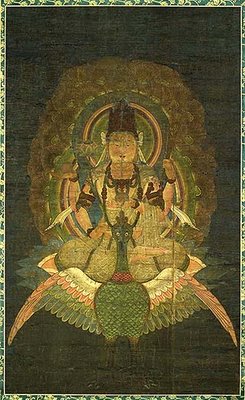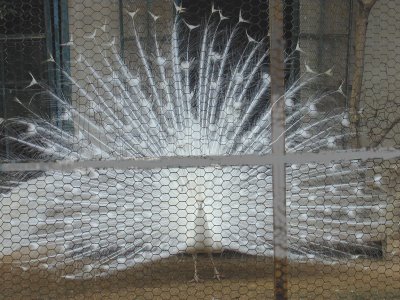:::::::::::::::::::::::::::::::::::::::::::::::::::::::::::::::::::::::::::::::::::::::::::::::::::::
Peacock Wisdom King 孔雀明王 Kujaku Myo-O
梵語名:マハーマーユーリー
Skt. Mahamayuri
Mahamayuri vidyarajni : The peacock goddess of wisdom
In his female aspect also defined as : Kujaku Bosatsu
Wards off evil from poisoning or calamity; prayed to in times of drought, poisoning, and disaster; rides a peacock (in India, the peacock is famous for eating poisonous snakes); one face, four arms.
Mark Schumacher on Kujaku Myo-O
Peacock Myo'o (Mayura Vidyaraja)
This work depicts an unusual form of a Myo'o (Vidyaraja), descending from Heaven on a peacock accompanied by clouds. This figure, with its three faces and six arms, differs from the Japanese style Kujaku Myo'o (Mayura Vidyaraja), which usually has one face and four arms. In contrast to the central face, which suggests a merciful disposition, the side faces appear fierce.
孔雀明王 Kujaku Myo-O
. Kyoto National Museum .
:::::::::::::::::::::::::::::::::::::::::::::::::::::::::::::::::::::::::::::::::::::::::::::::::::::
くじゃくみょうおう
仏教のうちでも神秘性を重んじる密教(みっきょう)という宗派で信仰されたホトケさまの絵には、ふだん見慣れない不思議な絵があります。鳥の上にすわっていたり、ライオンの冠をかぶっていたり、火炎を背負っていたり。手の数も二本ではなく、何本もあったりします。なかでも「明王(みょうおう)」という怒りの表情をとるホトケの一群は、密教特有のものでした。

孔雀明王像 <安楽寿院>
孔雀明王 Kujaku Myo-O
. Kyoto National Museum .
:::::::::::::::::::::::::::::::::::::::::::::::::::::::::::::::::::::::::::::::::::::::::::::::::::::
More about Rain Rituals (amagoi, kiu あまごい 祈雨)
:::::::::::::::::::::::::::::::::::::::::::::::::::::::::::::::::::::::::::::::::::::::::::::::::::::
Kujaku (Mahaa Mayuuri)
Der "Pfauen-Myoo-oo".
Hat als einziger Myo-O einen milden, barmherzigen Gesichtsausdruck und eine Figur wie ein weiblicher Bosatsu. In alten Schriften auch "Makamayuri" genannt.
Sutra: Butsumo Daikujaku Myo-O Kyoo.
Neutralisiert Schlangengift (Pfau frißt Giftpflanzen, giftige Tiere und Giftschlangen); heilt auch Fieber und Schmerzen und die Unsicherheit des Herzens. Schützt vor Naturkatastrophen.
In Japan als Gottheit für Regenzauber (kiu) verehrt.
Dieser Myo-O ist der älteste von allen Myo-O-Gottheiten. Die älteste Statue in Japan (Nara-Zeit) findet sich in der Goldenen Halle im Tempel Saidaiji in Nara.
Ikonografie:
Ein freundliches Gesicht, vier Arme. Keine flammenartigen Haare sondern Hohe Krone. Hält geöffnete Lotusblüte, Granatapfel, Buddha-Frucht sowie fünfschweifige Pfauenfeder in den Händen.
Reitet auf einem Lotussockel auf einem Pfau mit einem Nimbus aus Pfauenfedern.
Quoted from my book
Buddhastatuen - Who is Who
:::::::::::::::::::::::::::::::::::::::::::::::::::::::::::::::::::::::::::::::::::::::::::::::::::::
................... HAIKU 俳句

a white peacock
under cherry blossoms -
visiting the zoo
© Gabi Greve
:::::::::::::::::::::::::::::::::::::::::::::::::::::::::::::::::::::::::::::::::::::::::::::::::::::
in a spring breeze
spreading his tail
peacock
(harukaze ni / hane hirogetaru / kujaku kana)
Masaoka Shiki
Read a discussion about translating this haiku:
Peacock, Kujaku Haiku
ooo ooo ooo ooo ooo ooo ooo ooo ooo
monsoon clouds array
on the car front glass ~
a peacock's loud cry
Narayanan Raghunathan, India
New crop waves
Walks like a peacock
Village damsel
(Punjabi, Satyanand Jaya)
http://www.lifepositive.com/Mind/arts/new-age-fiction/satori.asp
ooo ooo ooo ooo ooo ooo ooo ooo ooo
PEACOCK Haiku Club, Kenya
ooo ooo ooo ooo ooo ooo ooo ooo ooo
Around here (Chesapeake Bay, USA), the peacocks spreading their tales would be an early summer kigo, as that is the mating season. Take this from me, who was once a zookeeper and has shoveled quite a lot of peacock manure!
azure summer
peacocks rattle their tail feathers
peahens ignore them
Peacocks not only spread their tales, but they shiver, which causes the tail feathers to rattle. The rattle of the feathers is a distinctive sound and is part of the mating ritual -- the peacocks are trying to attract attention. Most of the time the hens don't seem very interested. Nonetheless, the cocks must be successful because a few weeks later there will be scores of nests with eggs, and then the chicks hatch. Each hen will lay 3 - 12 eggs most of which will live.
Then the hens will parade with their chicks in a line.
I stop abruptly,
too much traffic!
a peahen with seven chicks.
There must have been a hundred or more of the peafowl. What an amazing sight to see them roosting in the oak trees, strolling the paths, and everywhere! Peafowl do not fly, but they jump and glide and in this manner can get quite high up in the trees. The largest of the cocks must have been around thirty pounds, and I occasionally saw him up a tree. They almost never hurry, even when they are getting a running start to jump and glide. I have seen them stroll up to a fence then suddenly leap five feet up.
blue, green and silver,
trees full of living jewels--
a flock of wild peacocks
The peafowl flock is the descendants of a pair that were bought as living lawn ornaments back in the 50s. The zoo was a farm then. The peafowl found it to their liking and have multiple and naturalized. People might think it strange that these 'tropical' birds survive our winters, but the peacock is really nothing more than the Asian turkey. Biologically they are very closely related to the North American wild turkey, eating the same foods and suffering from the same disorders.
Unaware that they
are living lawn ornaments,
peacocks stroll the grounds.
Among Native Nations in this area, the tail feathers of the wild turkey were (and still are) used to make feather cloaks. The feather cloak is the badge of office for a Lenape chief, and having seen a chief in his cloak, I can assure you, such a cloak is an extraordinarily beautiful thing! The duties of a Native chief are those of leadership, protection, and compassion for his people, so I see a parallel with the myoo.
December morning,
wild peacocks roosting
among the oak trees.
M. Kei
Editor of the Chesapeake Bay Saijiki, USA
:::::::::::::::::::::::::::::::::::::::::::::::::::::::::::::::::::::::::::::::::::::::::::::::::::::

Peacock and apple blossoms
Bairei Kono (1844-1895)
:::::::::::::::::::::::::::::::::::::::::::::::::::::::::::::::::::::::::::::::::::::::::::::::::::::
..................More Peacock KIGO
peacock butterfly, kujakuchoo 孔雀蝶
Kigo for all spring
peacock flies, fruit flies, kujakubae, shoojoobae 孔雀蝿,ショウジョウバエ
Kigo for all summer
Marigold, (Peacock plant) kujakusoo 孔雀草
harushagiku 波斯菊(はるしゃぎく)"Persian chrysanthemum"
janomesoo 蛇の目草(じゃのめそう)"snake eye plant"
koo oo soo 紅黄草(こうおうそう)
manjugiku 万寿菊(まんじゅぎく)"long live chrysanthemum"
marigoorudo マリーゴールド Marigold, Tagetes
kigo for late summer
. Marigold garlands in India .
. - The Six Birds of Paradise - 浄土の鳥 - .
:::::::::::::::::::::::::::::::::::::::::::::::::::::::::::::::::::::::::::::::::::::::::::::::::::::::
[ . BACK to DARUMA MUSEUM TOP . ]
[ . BACK to WORLDKIGO . TOP . ]
:::::::::::::::::::::::::::::::::::::::::::::::::::::::::::::::::::::::::::::::::::::::::::::::::::::::
hilltop pheasant
ReplyDeleteare you jealous of the heron's
style?
Issa
Issa has about 70 haiku about the pheasant.
Check out the Database of David Lanoue.
. ISSA ARCHIVES by David Lanoue .
::::::::::::::::::::::::::::::::::::::::::::::::::::::::::::::::::::::
This comment has been removed by a blog administrator.
ReplyDeleteGabi san,
ReplyDelete一茶のKijiが孔雀の家で遊んでいますよ!
sakuo
Legend from Chuo ward, Tokyo
ReplyDeleteKakigaracho 蛎殻町 / 蠣がら町
. kitsune densetsu 狐と伝説 fox legends .
The kujaku 孔雀 peacock which had been kept in a cage at the estate in Kakigaracho was killed and the Samurai was very angry about it. He even destroyed 稲荷の社 the Inari Fox Shrine in the compound. At night a fox appeared in his dream. The fox said he was not responsible for the death and would prove it within three days.
The next day the fox appeared again in his dream and said he had punished the criminal.
When the Samurai stepped out next morning, he found a large old fox lying dead on his doorstep.
.
https://edoflourishing.blogspot.com/2018/11/chuo-ward-legends.html
.
Legend from Nara
役行者が「生駒山中の2匹の鬼を捕らえて人々を救え」との孔雀明王の霊夢を授かり、21日山に籠って行をして、満願の日に不動緊縛の法をもって鬼を捕らえた。鬼はついには髪を切って行者の弟子になった。これが前鬼・後鬼である。この山を鬼取山とよび、集落を鬼取という。
.
and two more
http://www.nichibun.ac.jp/cgi-bin/YoukaiDB2/msearch/msearch.cgi?index=&config=&hint=%E3%81%B2%E3%82%89%E3%81%8C%E3%81%AA&set=1&query=%E5%AD%94%E9%9B%80
.